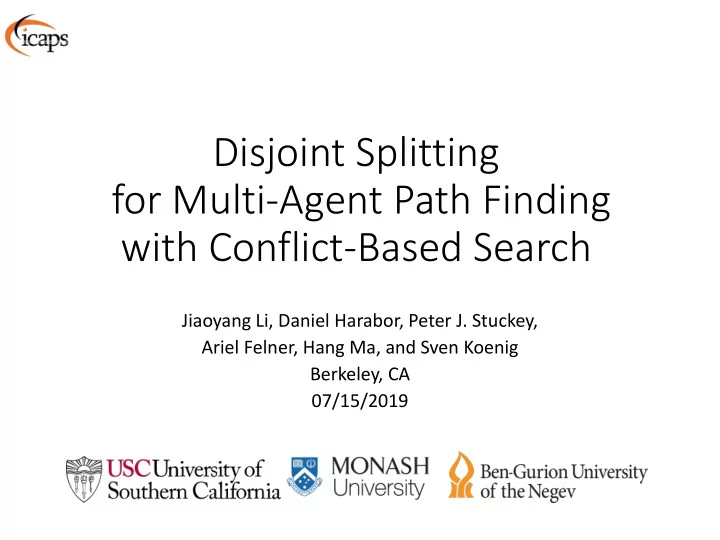

Disjoint Splitting for Multi-Agent Path Finding with Conflict-Based Search Jiaoyang Li, Daniel Harabor, Peter J. Stuckey, Ariel Felner, Hang Ma, and Sven Koenig Berkeley, CA 07/15/2019
Multi-Agent Path Finding (MAPF) 2 1 1 2 • Goal: • Find collision-free paths. • Minimize the sum of path costs. • MAPF is NP-hard to solve optimally.
Conflict-Based Search (CBS) Resolve a conflict Plan paths by adding new independently for Check for conflicts. constraints. each agent. Both agents are at C at time 3. 2 A B C 1 1 2
Conflict-Based Search (CBS) Resolve a conflict Plan paths by adding new independently for Check for conflicts. constraints. each agent. Repeat until finding collision-free paths. Replan paths that satisfy the constraints. Case 2: Case 1: Agent 2 cannot be at C at time 3. Agent 1 cannot be at C at time 3. A B C 2 1 A B C OR 1 1 2 2
Conflict-Based Search (CBS) • The high-level of CBS searches in a binary tree using a best-first manner. • The low-level of CBS replans paths for single agents.
The splitting of CBS • To resolve a conflict between agents 𝑗 and 𝑘 at vertex 𝑤 at time 𝑢 : ⟨𝑗, 𝑤, 𝑢⟩ : Agent 𝑗 cannot be at 𝐷 vertex 𝑤 at time 𝑢 . 𝐷 ∪ 𝑗, 𝑤, 𝑢 𝐷 ∪ 𝑘, 𝑤, 𝑢 • The searching spaces (i.e., sets of paths that satisfy the constraints) of the two child nodes are not disjoint ! • The following pair of paths satisfies both constraints. Time 0 … 𝑢 … 𝑤 ′ 𝑡 𝑗 … … 𝑗 Path for 𝑗 𝑤 ′′ 𝑡 … 𝑘 … … … Path for 𝑘 𝑘
The splitting of CBS • Non-disjoint splitting: • Disjoint splitting: 𝐷 𝐷 𝐷 ∪ 𝑘, 𝑤, 𝑢 𝐷 ∪ 𝑗, 𝑤, 𝑢 𝐷 ∪ 𝑗, 𝑤, 𝑢 𝐷 ∪ ⟨𝑗, 𝑤, 𝑢⟩ • Negative constraint ⟨𝑗, 𝑤, 𝑢⟩ : • Positive constraint 𝒋, 𝒘, 𝒖 : • Agent 𝑗 cannot be at 𝑤 • Agent 𝑗 must be at 𝑤 at time 𝑢 . at time 𝑢 . • Any other agents (including agent 𝑘 ) cannot be at 𝑤 at time 𝑢 .
Example 2 1 A B C 1 2 • Non-disjoint splitting: 8 ⟨1, 𝐷, 3⟩ ⟨2, 𝐷, 3⟩ 9 8 ⟨2, 𝐶, 2⟩ ⟨1, 𝐶, 2⟩ 9 8 ⟨2, 𝐵, 1⟩ ⟨1, 𝐵, 1⟩ 9 9
Example 2 1 A B C 1 2 • Non-disjoint splitting: • Disjoint splitting: 8 8 ⟨1, 𝐷, 3⟩ ⟨2, 𝐷, 3⟩ ⟨1, 𝐷, 3⟩ ⟨1, 𝐷, 3⟩ 9 9 8 8 ⟨1, 𝐶, 2⟩ ⟨2, 𝐶, 2⟩ ⟨1, 𝐶, 2⟩ ⟨1, 𝐶, 2⟩ 9 8 8 ⟨2, 𝐵, 1⟩ ⟨1, 𝐵, 1⟩ ⟨1, 𝐵, 1⟩ ⟨1, 𝐵, 1⟩ 9 9 9
Example 2 1 A B C 1 2 • Non-disjoint splitting: • Disjoint splitting: 8 8 ⟨1, 𝐷, 3⟩ ⟨2, 𝐷, 3⟩ ⟨1, 𝐷, 3⟩ ⟨1, 𝐷, 3⟩ 9 9 8 8 ⟨1, 𝐶, 2⟩ ⟨2, 𝐶, 2⟩ ⟨1, 𝐶, 2⟩ ⟨1, 𝐶, 2⟩ 9 8 8 ⟨2, 𝐵, 1⟩ ⟨1, 𝐵, 1⟩ ⟨1, 𝐵, 1⟩ ⟨1, 𝐵, 1⟩ 9 9 9
Low-level search of CBS • Non-disjoint splitting • Replan the entire path. • Disjoint splitting • Replan the path segment between two positive constraints.
Experiments Expanded nodes 10,000,000 Non-disjoint 573,004 1,000,000 Disjoint 2 62,429 100,000 7,447 1 10,000 Nodes 1,015 1,000 2,352 142 1 935 100 339 22 110 2 3 10 38 11 1 3 2x2 rectangle conflict 2X2 3X3 4X4 5X5 6X6 7X7 8X8 Rectangle size
Experiments Success rate (%solved instances within 5 minutes) 1.00 1.00 Success Rate 0.80 Success Rate 0.80 0.60 0.60 0.40 0.40 0.20 0.20 0.00 0.00 10 20 30 40 50 60 20 30 40 50 60 Agents Agents 1.00 1.00 Success Rate Success Rate 0.80 0.80 0.60 0.60 0.40 0.40 0.20 0.20 0.00 0.00 10 12 14 16 18 20 20 40 60 80 100 120 140 Agents Agents
Takeaways • The splitting of standard CBS is not disjoint. • Disjoint splitting: 𝐷 Positive constraint: • Agent 𝑗 must be at 𝑤 at 𝐷 ∪ 𝑗, 𝑤, 𝑢 time 𝑢 . 𝐷 ∪ ⟨𝑗, 𝑤, 𝑢⟩ • Any other agents cannot be at 𝑤 at time 𝑢 . • Empirically, disjoint splitting is at least as good as CBS splitting and significantly speeds up CBS in many cases.
Recommend
More recommend